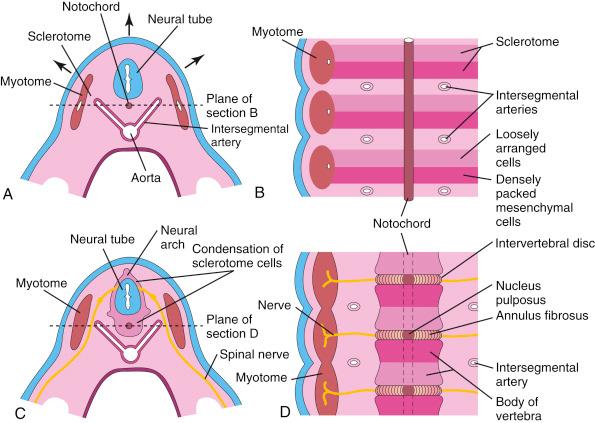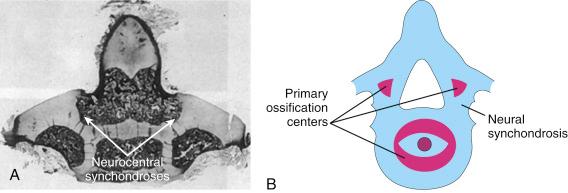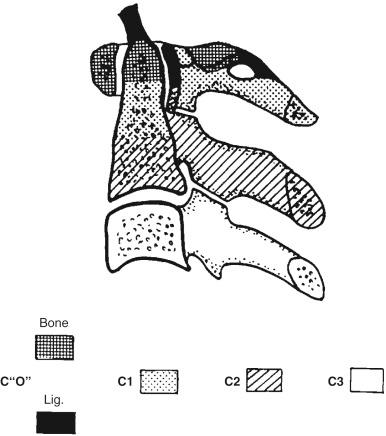Physical Address
304 North Cardinal St.
Dorchester Center, MA 02124
|
|
|
|
|
|
|
|
Congenital anomalies of the pediatric cervical spine arise from a failure of normal development occurring early in the embryonic process. These anomalies can lead to problems for treating physicians and surgeons. Because the immature spine is largely cartilaginous, recognition and definition of pathologic features can be difficult even for experienced clinicians. Failure to recognize these pathologic processes risks overlooking segmental instability, developing progressive spinal deformity, encroachment on the space available for the spinal cord (SAC), and the risk for myelopathy. To recognize congenital anomalies and best manage these patients, it is helpful to understand the embryology and biomechanics of the normal immature cervical spine. Once these fundamental issues are understood, then anomalous development can be better appreciated.
By the end of the fifth week of development, mesodermal cells that surround the notochord segment into epithelial spheres called somites ( Fig. 6-1 ). This process is known as segmentation and produces 42 to 44 pairs of somites. The somites develop in a craniocaudal fashion, and each somite has three parts: the sclerotome, the dermatome, and the myotome. The sclerotomes are responsible for the formation of the vertebrae, whereas the dermatomes and myotomes are responsible for the formation of the overlying dermis and muscles, respectively.

The paired aggregation of cells within the somites is patterned so that the cells in the caudal half are densely packed and the cells in the cranial half are loosely packed (see Fig. 6-1 ). Separation or segmentation of the stacked somites occurs through the loosely packed cells in the cranial half of each somite. The cranial half becomes the disk space and the annulus fibrosus, whereas the caudal, tightly packed half of the somite becomes the vertebral body. Finally, the notochord slowly regresses to become the nucleus pulposus within the annulus fibrosus.
For one complete vertebra to form properly, a tight interaction between a pair of somites is necessary. Failure of the proper segmentation process may result in congenital abnormalities. Two families of regulatory genes have been implicated in the control of the processes of somitogenesis and segmentation: Pax and Hox . The Pax family of genes contributes to the development of the central nervous system and also controls the establishment of boundaries for each sclerotome. The Hox family of genes regulates the sequential craniocaudal development of the midline axial structures. Mutations in these genes may contribute to the development of congenital anomalies and are a topic of ongoing investigation.
During the sixth week of development, chondrification occurs and ultimately leads to ossification of relevant structures and regression of the notochord. Defects in these two processes, which are controlled by signals from the notochord, can lead to congenital abnormalities. The vertebrae of the lower cervical spine (C3 to C7) have a similar pattern of development. Each vertebra has three primary ossification centers: one on either side of the neural arch and one in the vertebral centrum. The ossification centers are separated anteriorly by the neurocentral synchondroses, which lie parallel to each other on either side of the centrum ( Fig. 6-2 ). To develop normal vertebral growth, it is important for the neurocentral synchondroses to have paired growth that is symmetric and equal. Asymmetric growth leads to deformity. Normally, the synchondroses close between 6 and 8 years of age, at which time the spinal canal diameters have reached adult size. Premature closure of the neurocentral synchondroses may lead to reduced spinal cord diameters with an increased risk of spinal stenosis and deformity.

Additional organ systems are derived from the same primitive areas of the mesoderm. Any process that can affect the normal development of the mesoderm can lead to spinal defects, as well as anomalies in other areas. The estimated incidence of additional abnormalities in children with congenital spinal anomalies is up to 60%. The genitourinary system is most commonly associated with congenital spine abnormalities.
The development of the occipitoatlantoaxial complex is a unique variation of the foregoing process ( Fig. 6-3 ).

Become a Clinical Tree membership for Full access and enjoy Unlimited articles
If you are a member. Log in here